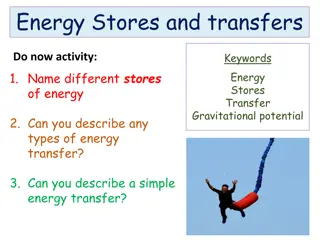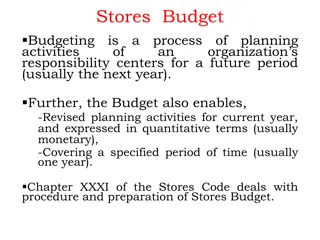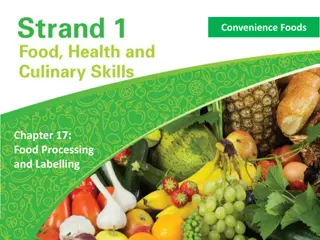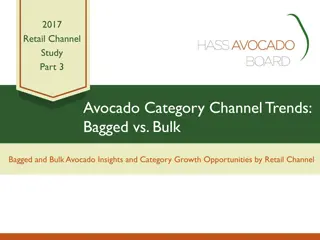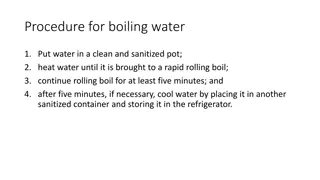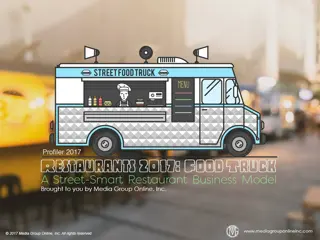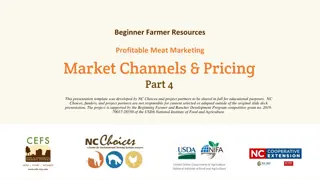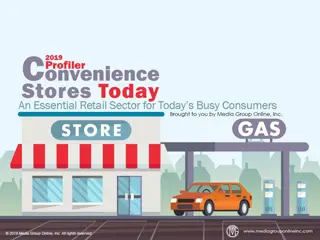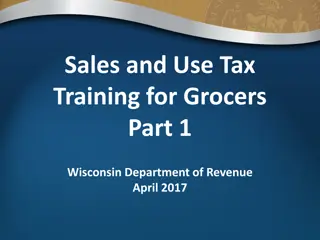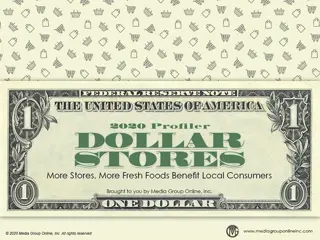Maximizing Foodservice Sales in Convenience Stores
Convenience store owners are focusing on increasing in-store consumer spending by enhancing their foodservice offerings to compete with other food establishments. While large operators are optimistic about growing foodservice sales, challenges such as consumer perceptions and competition exist. Consumers show interest in prepared foods like pizza and fresh-baked goods, presenting a lucrative opportunity for convenience stores to attract more customers with healthier products.
Download Presentation

Please find below an Image/Link to download the presentation.
The content on the website is provided AS IS for your information and personal use only. It may not be sold, licensed, or shared on other websites without obtaining consent from the author.If you encounter any issues during the download, it is possible that the publisher has removed the file from their server.
You are allowed to download the files provided on this website for personal or commercial use, subject to the condition that they are used lawfully. All files are the property of their respective owners.
The content on the website is provided AS IS for your information and personal use only. It may not be sold, licensed, or shared on other websites without obtaining consent from the author.
E N D
Presentation Transcript
Attracting More Customers with Healthier Products Convenience stores have few, if any, competitors for motor- fuel sales, selling approximately 80% of all it in the US, but they are fiercely competing for in-store consumer spending, and foodservice is the current and future battleground. C-store s in-store sales of $242.2 billion was 37% of the industry s 2018 total revenues of $654.3 billion. They would like to increase it as they compete with fast-food and other restaurants, coffee shops, grocery stores, food trucks, drug stores and other C-stores. Foodservice was the second largest generator of those $242.2 billion, or 22.6%/$54.74 billion and, although tobacco was the largest, or 37.8%/$91.55 billion, its sales are declining as foodservice becomes the new revenue opportunity for C-stores.
C-Store Owners Recognize the Opportunity C-store owners clearly understand the foodservice opportunity, as 90% of large operators expected their 2019 foodservices sales to increase, and 93% their profits, while 75% of small operators expected increased sales and 66% increased profits. Although 39% of the C-store operators surveyed for the Convenience Store News Foodservice Study 2019 said competition was a major obstacle to increasing foodservice sales, it was second to difficulty in hiring & retaining employees, at 66%. Other obstacles they cited were store-level operational inefficiencies 33%, finding the right products/programs 29%, less in-store foot traffic 22%, negative consumer perceptions of C-store foodservice 18% and supply chain 14%.
Consumers Still Not Sure About C-Store Foodservice Although only 18% of C-store owners cited consumers negative perceptions of C-store foodservice as an obstacle to increasing sales, just 27% of the 61% of C-store shoppers who said they were health-conscious were satisfied with C-store healthy offerings. 2019 data from Convenience Store News revealed fast-food restaurant shoppers top reasons for avoiding C-store foodservice were food freshness 43% and food quality 39%, compared to 39% and 36%, respectively, for grocery shoppers. Another challenge for C-stores is fast-food shoppers are more likely to consider them a source of snacks instead of meals: breakfast 29%, mid-morning snack 32%, lunch 26%, afternoon snack 38%, dinner 20% and late-night snack 35%.
Consumers Are Attracted to Prepared Foods According to Convenience Store News Foodservice Study 2019, prepared food accounts for 51% of all foodservice sales, or approximately $28 billion. Cold, dispensed beverages were responsible for 25% of foodservice sales, and hot, dispensed beverages 22%. Of the 51% of prepared food sales (of total foodservice sales) at C-stores, small operators actually derived a larger percentage of sales from prepared food than large operators, or 56% and 42%, respectively. Convenience Store News also reported in additional 2019 data that C-store foodservice shoppers purchased pizza the most at 38%, followed by fresh-baked goods 30%, breakfast sandwich/wrap 30%, hot dog 29% and cold sandwich/wrap 26%.
New Food Choices and Delivery Services Are Key Freshness and quality are certainly important to foodservice consumers considering a purchase at a C-store, but consumers want convenience, too, which is why C-store operators are adding many amenities. An interesting contrast is more large than small C-store operators plan to add take-home/heat & eat dinner solutions, or 16% and 5%, respectively, while more small than large operators plan to add cook-at-home meal kits, or 12% and 5%, respectively. Large C-store operators are taking the lead in delivery services, as the Convenience Store News 2019 data revealed 16% were providing third-party delivery (small operators, 3%) and 8% in-house delivery vs. 3% of small operators.
Loyalty Programs and Social Media Are Primary Promotional Channels Analysis of the data from the Convenience Store News Foodservice Study 2019 indicated operators were feeling the competitive pressure in the foodservice category, as 51% of them said they increased their foodservice promotions during the past year. Unsurprisingly, a larger percentage of large operators than small operators increased their promotions, or 65% and 44%, respectively, while 47% of small operators didn t increase their promotions, compared to 32% of large operators. Large C-store operators were much more likely to use a loyalty program as a foodservice promotional channel than small operators, or 78% and 31%, respectively. Small operators are at a disadvantage, as 34% don t promote foodservice versus just 3% of large C-stores.
Advertising Strategies UPDATED Most C-stores marketing messages should emphasize the steps stores have taken to make in-store foodservice purchases as safe as possible during the pandemic as well as any extra protocols suppliers have initiated to make the food safer at its sources. Consider a Sunday Drive promotion targeting families, offering a discount on a combo package of foodservice items or for spending a certain amount, so families can safely take their children for a drive in the country and have an in-car picnic. C-stores that hadn t previously considered curbside service and/or a delivery option can now use this opportunity to implement these additional customer services, test their value and include them as part of the stores standard operations.
New Media Strategies UPDATED In conjunction with the Sunday Drive promotion, ask customers to record and share short videos of their trip and how much they enjoyed the foodservice choices from the C-store. For C-stores planning to expand their foodservice offerings prior to the pandemic, conduct a poll with photos of these new foodservice products, asking customers/social media visitors to vote on their favorite. Give a participant a digital coupon for use during the future. Use social media to encourage customers and local consumers to take a break from being at home and visit their local C-store for lunch items just as they did before the pandemic. Give these customers a discount coupon to apply to a future lunch once they return to work.


